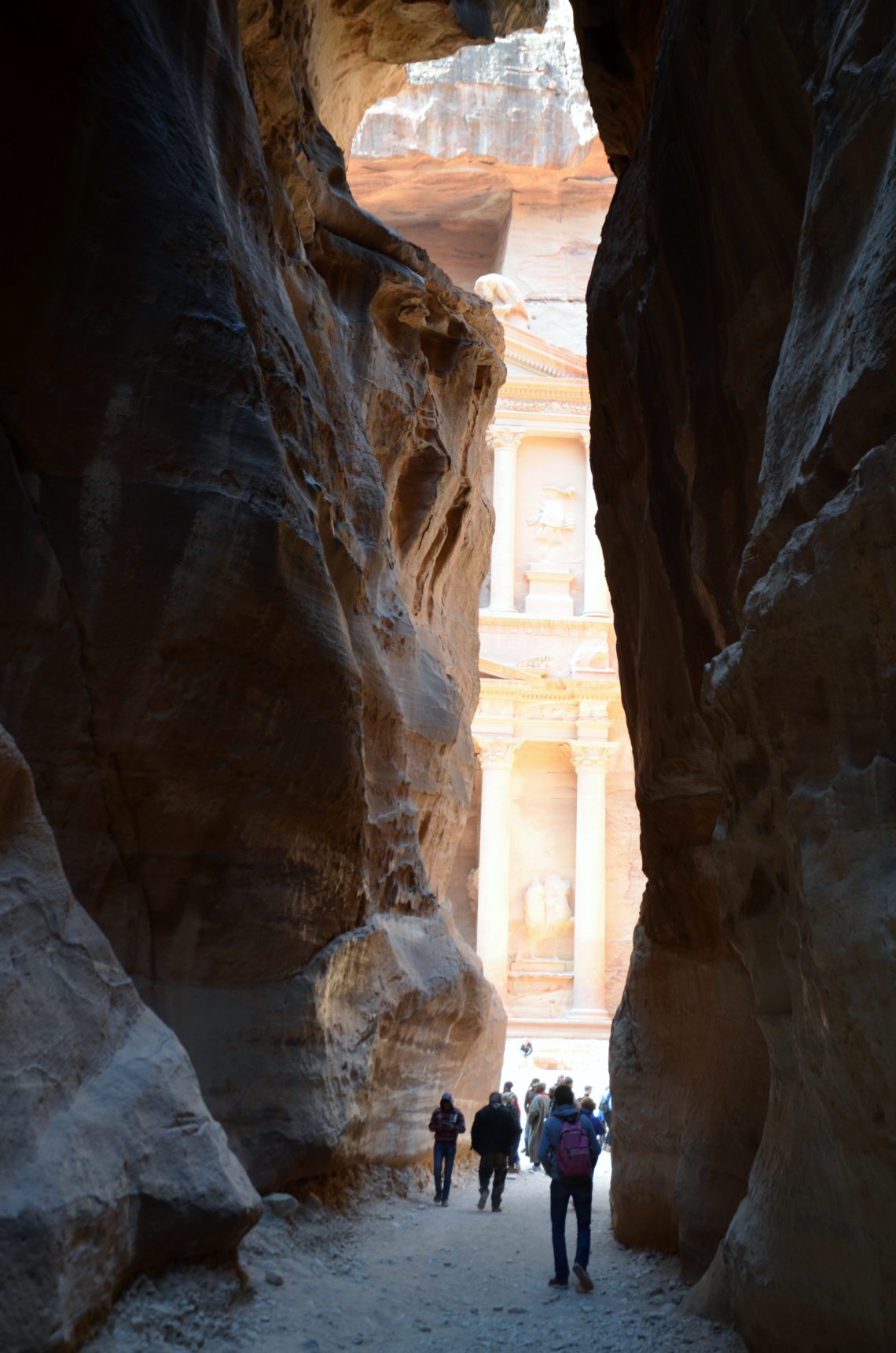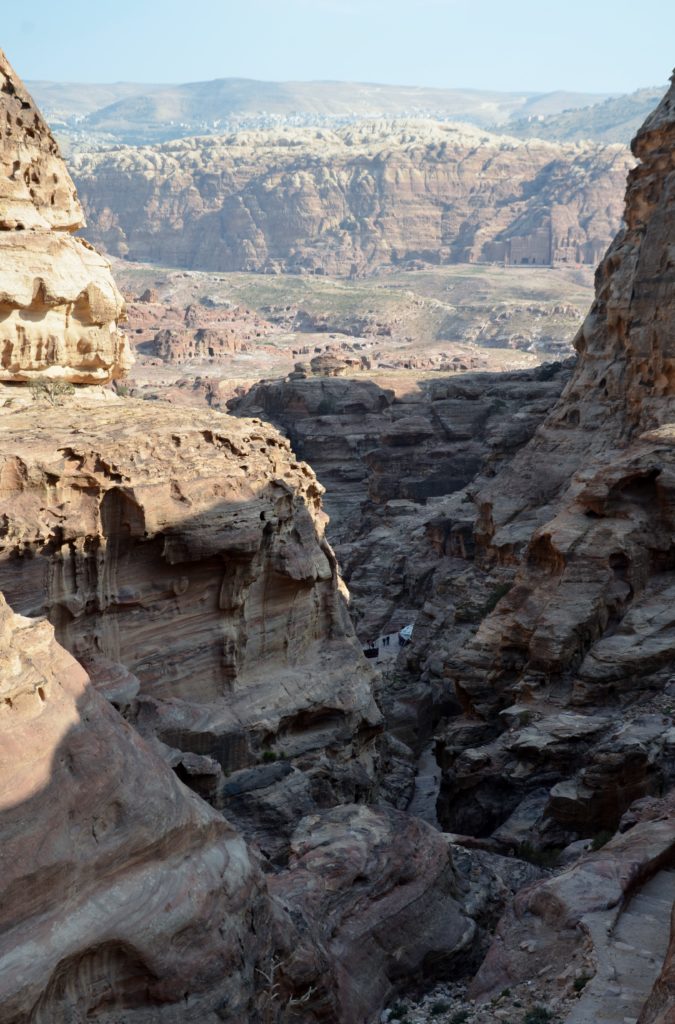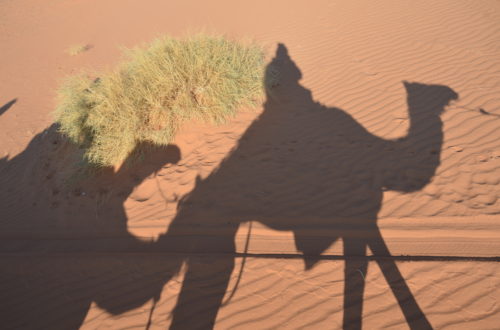
A dream come true: visiting Petra
Ever since I saw pictures of Petra in National Geographic years ago I wanted to go there. In 2015 that dream finally came true. Visiting Petra was everything I expected it to be and more. We visited Petra as part of our tour through Jordan.
Visiting Petra: some history
The start of Petra goes back to before Christ. The Nabataean, nomad people from Western Arabia, took over caravan routes. This way they founded a sort of ‘caravan kingdom’, with Petra as the blossoming capitol. Most of the buildings in the centre of Petra were built between 9 BC and 40 AC. The water plumping through the Siq is from the same time.

After 106 AC Petra came under the influence of the Romans. That’s when Petra got her present look. The colonnadestreet, temple, thermen and theatre are from the Roman era. But despite all this Petra lost it’s position to Bosra and Palmyra.

Decline
In the fourth century there were a few severe earthquakes. Christianity reached Petra and because of that a few buildings have a Christian function. In the 8th century there were even more earthquakes and Petra was forgotten by the world, except for the Bedouin.
Rediscovery
In 1812 Johann Ludwig Burckhardt is the first European to see the rose red city in ages. He told the Bedouin he wanted to visit the grave of Aäron. The Bedouin couldn’t refuse his request. In 1929 the first excavations started.
Our visit
Our visit started at the visitor center. Our Jordanian guide wasn’t allowed to guide us in Petra, only guides from Petra. He walked with us till the Treasury.

From the visitor center until the start of the Siq, there are already monuments to be seen in the rocks. After this path you walk through the Siq, a small canyon. At the end of the Siq is the most famous image of Petra, the Treasury. Although having seen lots of photos of this, it was still mesmerizing. At the last bend in the canyon you get a peek of the Treasury and then you’re in the open and you see the whole beautiful building.

The rest of Petra

At the Treasury the Petra guide said goodbye and we walked further on our own. Faisal, our Jordanian guide, had gone with us and walked further with us, but not through the whole of Petra. We walked past the colonadestreet and than started on the 800 stairs up to the Monastry. The second most famous image of Petra.

We walked with the other family from our tour. Two of their children encouraged Yuri to walk all those stairs. After all the climbing we came to the Monastry, which was worth the climb. We had our lunch there, sandwiches we had taken with us from the hotel.
And further we walked
After lunch and admiring the Monastry a little bit more we walked all the stairs down again. We visited a church and the Kings graves after this. Then we walked back the same route. Passed the Treasury, through the Siq and all the way back to the visitor center. We were exhausted, after walking approximaly 12 kilometres with lots of stairs. But it was so worth it and I would do it again, visiting Petra, in a heartbeat.

Petra by Night
The plan was to go to Petra by Night in the evening. But by then I was so exhausted that I just didn’t have the energy anymore. This is still on my to do list, since I would love to see Petra by candlelight. So we have to go visit Petra again!
Some Facts
From the visitor center till the Siq is 700 metres. The Siq is a small canyon, 70 metres high and in some places only 4 metres wide. The Siq is 1.2 kilometres long. So by the time you reach the Treasury you have walked almost 2 kilometres (and you have to walk the same route back). After the Siq, the canyon widens and even more after the Treasury.
The canyon itself came into existence because of a fraction in the rock.
Petra is the Greek name for the capitol of the Nabataean. The Nabataean itself called it Raqmu.
Petra is on the UNESCO world heritage list since 1985. Petra is known as the rose-red city. It’s the city of rock. These names are because Petra is known for being carved out of rose-red rocks. Despite of the names Treasury or Monastry, they’re grave tombs.
Good to know
When we visited in 2015 we couldn’t see the inside of the Treasury and Monastry.

The Bedouin are ‘everywhere’ trying to sell their souvenirs. There are a few restaurants in Petra itself. The Bedouin have the exploitation rights inside Petra. Horse rides are included in the entrance fees. The tip isn’t included. Horses aren’t allowed further than the entrance to the Siq. A horse drawn cart is allowed to go to the Treasury, but it isn’t free. The price of the cart doesn’t include the tip.
Prices
As of 2020 these are the entrance fees:
One day ticket 50 JD (about 60 euros).
Two day ticket 55 JD (about 65 euros).
Three day ticket 60 JD (about 70 euros).
Children under the age of 12 are free.
Opening hours:
Petra + visitor center are open 6 am – 6 pm, winter 6 am – 4 pm. Petra by Night takes approximaly 1,5 hours. It’s on Monday, Wednesday and Thursday evening. Fee is 17 JD (about 20 euros), children under the age of 12 are free. It takes place from 8.30 pm till 10 pm.
Conclusion
Visiting Petra is high on everyone’s list who goes to Jordan and with good reason. It’s well worth the effort and time. If you can spare more than one day in your itinerary for Petra I would certainly do this. It’s a must on road trips through Jordan.
Like it? Pin it!

Like it? Pin it!





52 Comments
Katie
We would love to visit Petra, it has been on our bucket list for so so long now. Love your pictures – have bookmarked for when we can start travelling again!
Cosette
Hope you get to go to Petra when it’s safe again. It’s definitly worth your time. It did not dissapoint us.
Holidays from Hels
I’ve always wanted to visit Petra. Looks absolutely beautiful. Would love to add in a horse ride!
Cosette
I’m less into horse rides. They would be bumpy here in Petra, but could be fun if you like horse riding.
World of Lina
Petra is one of my top places on my bucket list! I’ve seen so many photos of it and just can’t wait to go there 🙂
Cosette
In real life it’s even better than the pictures and vaster than what you usely see.
Arabela
Petra looks incredible and definitely worth visiting, but gosh, the entry fees are insane! Glad you got the chance to see it though!
Polly
Love Petra! Visited Jordan and Petra a few years ago and it was certainly one of the best places that I have ever been to! Love your article it made me go back in time and remember the beauty of this place. Love this post. Thank you for sharing!
Cosette
Yes, it’s on top of my best places also. Next to Iceland and the national parks in the USA.
katy kuhlwilm
Petra has been on my list for a while! I’d love to spend a lot of time exploring neighbouring countries too. I’ll save this post for when I finally get booked!
Cosette
From the neighbouring countries we only visited Israel and that was on a prior trip. Would love to visit the neighbouring countries of Jordan some day.
Jamie
Petra is one of my bucket list locations, loved reading about your experiences there and getting to momentarily travel vicariously through your post!
Cosette
Happy that you got to visit through my experiences, and it’s truly a spot that deserves to be on anyone’s bucket list.
Valerie
This is amazing! I would love to visit one day, seems like such a special experience! Thanks for sharing all the information and your beautiful photos! 🙂
Cosette
Thank you. It’s really is a special experience, one I will remember the rest of my life.
Meghan Emcee
Petra is so high on my list, this was so useful! Definitely saving for when I go!
Cosette
Glad it’s useful. Hope it can help you when you get to go to Petra.
Jiayi Wang
I loved Petra so much, it was just breathtaking!! These are some great tips 🙂 Thanks for making me reminisce on this beautiful place!
Cosette
I also still reminisce about it. Loved Petra. It did not disappoint. It’s even more beautiful in real life than in the pictures.
Shelley
Absolutely stunning photos! Petra has been on my list for some time now & you really provided some great info & things to think about when planning a trip there. Many thanks!! I’m saving this blog for later.
Cosette
Thank you and glad it’s helpfull in planning your own trip to it, for when it’s safe again.
Austin Cannon
This is definitely on my bucket list!
Kiara Gallop
Petra has been on my travel wish list for sooo long! Was hoping to visit this year but coronavirus had other ideas! Next year… ?
Cosette
Hope you get to visit next year Kiara. We had Lithuania, Poland, Estonia and Latvia on our list for this year, but hopefully get to visit those next year.
Cosette
I think it’s on everyone’s bucket list, or at least it should be.
Michelle
Oh…….I have wanted to visit Petra for years!! It’s high on our list of “must sees”. I had no idea how vast the area was……influencers only show a couple pictures. Thanks for all the info!!
Cosette
Yes, usually they show you The Treasury and The Monastry, but that’s it. There’s so much more, we didn’t get to explore every part of it.
Amanda OBrien
thanks for a return trip to Petra! I loved my visit there and reading your post brought it all back. such an amazing place!
Cosette
Glad I could make you return to Petra. I still love thinking about it.
Nicole
Some lovely pictures here, How long would you suggest to visit the surrounding areas also?
Cosette
We had one day here, but didn’t have time to explore everything and were to exhausted to go to Petra by night. I would say 2 days for exploring Petra would be better.
Curls en Route
I was supposed to visit this year :/ But this will definitely come in handy later!
Cosette
Oh, so bad you couldn’t/can’t go this year. Hope you can go next year.
Kooky Loves to Travel
This is my dream too! It looks absolutely gorgeous ! Thanks for sharing all those pretty photos!
Cosette
I hope you get to go some day. Thanks for the compliment about the photos.
Clazz - An Orcadian Abroad
Petra looks phenomenal! I’m hoping I’ll get the chance to go some time. I love the photos from the other parts of the area too as so often you see nothing except the Treasury.
Cosette
I hope you get to go some day to Petra, it’s really worth the visit. Yes, the Treasury is usually what they show from Petra, but it’s so much larger than just that.
He ni
I would love to visit Petra too, it is a dream!! Thank you for the history too. Very inspired to go here!
Cosette
Hope you can make it to Petra. Yes, I love history, so I just have to ad it.
Tia
I adored Petra so much too! Seeing up close senr chills down my spine!
Cosette
Yes, Petra was really beautiful. It did not disappoint seeing it in real life.
Marisa
Petra is so high on my bucket list and this is a great guide for when I can finally make it there some day! You’ve included tons of useful tips and information which will be so helpful!
Cosette
Hope you make it to Petra, definitly worth the time. Great that the tips and information in my post are helpful.
Aswani Kurra
Visiting Petra is my dream too! Hope it comes true soon. You are so lucky 🙂
Cosette
Yes, feel very lucky that I got to visit. Hope your dream comes through too and you get to visit Petra.
Maria
Petra is truly impressive! I’d love to visit someday, it must be so interesting to learn about the history behind it. The entrance fee is pretty expensive though!
Cosette
Petra is fantastic, so worth to visit and the entry fee. It’s massive.
Taylor
Petra is on my bucket list! I hope to go sometime in 2022. It looks like you had a wonderful time when you went. 🙂
Cosette
Hope you can visit Petra in 2022. It’s so beautiful.
Krista
As someone who loves ancient history, Petra is very high on my bucket list still. Your post has made me want to look into going even sooner! It looks incredible.
Mona
This is the best guide! Thank you
MicheleinPlaya
Your photos are glorious! Visiting Petra has been on our travel bucket list for a long time. I may need to push it closer to the top of the list. What do you think is the best time of year to visit Petra?